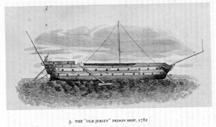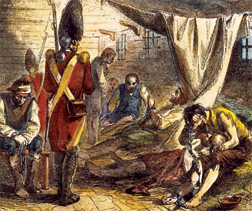April 2008
“Their sickly
countenances and ghastly looks were truly horrible…Some
swearing and blaspheming; some crying, praying and
wringing their hands, and stalking about like ghosts;
others delirious, raving, and storming; some groaning
and dying---all panting for breath; some dead and
corrupting—air so foul that at times a lamp could not be
kept burning.”
No,
it’s not an imaginary passage from Dante’s Inferno; it
was the way Robert Scheffield described the world he had
just escaped in July of 1778. It was one of more than 16
prison ships that were moored just offshore in
Wallabout
Bay on New York’s
East River. We don’t know which of these awful
ships Scheffield was on, as its name was never
mentioned, but we know it wasn’t the worst. That
distinction would go to a prison ship that would not
begin service for another year.
After the fall of New York in 1776 the
British found they did not have enough room to hold all
of their prisoners, especially with the large numbers of
American privateers they were capturing. So they turned
to converting some of their aging ships into floating
prisons. All of these ships were awful, but the worst of
them was the HMS Jersey. Most called the ship “The Old
Jersey” but those who were imprisoned there called it
“The Hell.” It had started life as a 64-gun ship in
1735, 144 ft long on deck and 41 feet wide. The masts
and rigging were cleared away and the ports were made
into 20-inch openings with crossed iron bars imbedded.
Below decks it was dark, filthy and stagnant. Often
there were over 1000 prisoners, mostly privateers,
packed into the rotting hull of the
Jersey.

Privateers were really the first American Navy. A
fast, privately owned ship would be outfitted with guns
and receive a letter of marque from the Continental
Congress to intercept and capture British shipping. The
Continental Navy had a total of 64 ships throughout the
war; there were close to 1,700 privateers. The Navy
captured 196 ships; privateers captured 2,283. A
successful cruise on a privateer could make a young
man’s fortune. Many of the privateer sailors had already
served as soldiers in the Army and now wanted to have a
chance at profit while they fought for liberty. The
rewards were high, but so were the risks. Approximately
50% of the American privateers commissioned were
captured. Some prisoners were sent to
England, captured Black privateers
were often sold into West Indies
slavery, but most privateers went to the hated prison
ships.
Day began on the Jersey
with the guards opening the hatches and calling “Rebels
turn out your dead.” Jersey prisoner Christopher Vail
wrote, “When a man died he
was carried up on the forecastle and laid there until
the next morning at 8 o'clock when they were all lowered
down the ship sides by a rope round them in the same
manner as tho' they were beasts. There was 8 died of a
day while I was there. They were carried on shore in
heaps and hove out the boat on the wharf, then taken
across a hand barrow, carried to the edge of the bank,
where a hole was dug 1 or 2 feet deep and all hove in
together.”
The
next part of the morning was spent listening to a
British officer, telling them daily that they had been
abandoned and left to die by their countrymen. The
standing offer made every day was release from their
suffering if they would join the British forces. Some,
undoubtedly, did take the offer.
We know from records that most would not betray
the cause of liberty even as they starved, sickened, and
died.
|

At
nine o’clock, the cook’s bell would ring and the
prisoners lined up for their rations. Those charged with
providing food to the prisoners were said to have grown
rich by starving the living and feeding the dead. These
provisioners were paid by the meals they provided and
would count dead prisoners as live ones they had fed on
their accounts while they would feed the living only a
small portion of the food they were supposed to (and
usually rotten food at that), getting paid as if they
had provided full meals. Water was drawn up from along
side the ship and poured into a giant rusted copper pot
where the meat was boiled. This description by a
prisoner shows how even these terrible conditions were
made worse: “The Jersey,
from her size, and lying near the shore, was embedded in
the mud; and I do not recollect seeing her afloat during
the whole time I was a prisoner. All the filth (read
sewage) which accumulated among upwards of a thousand
men, were daily thrown overboard, and would remain there
until carried away by the tide. The impurity of the
water may be easily conceived, and in this water our
meat was boiled.”
After food
rations came a work party, which allowed some men up
onto deck to perform cleaning and maintenance; the
majority it seems were kept inside. As the sun went
down, those few who had been working on deck faced
returning below. By the report of a prisoner named Dring,
“The working-party were soon ordered to carry the tubs
below, and we prepared to descend to our gloomy and
crowded dungeons. This was no sooner done, than the
gratings were closed over the hatchways, the sentinels
stationed, and we left to sicken and pine beneath our
accumulated torments, with our guards above crying
aloud, through the long night, ‘All’s well!’” By all
reports the nights were the worst time onboard with no
light, foul air and little sleep to be had amidst the
sounds of the sick and dying.
On July 4th 1782 the prisoners tried
to celebrate their independence as best they could in
their condition. Once on deck for their morning
indoctrination, the displayed 13 little flags they had
made. The flags were immediately torn down and trampled
by the guards.
Ignoring their captors, the Americans began to
sing patriotic songs, give speeches and raise cheers.
The guards quickly tired of this and drove the patriots
below at the point of bayonets, closing the hatches
above them. The singing continued until 9 o’clock at
night, when the enraged guards charged below with
lanterns and cutlasses. The patriots drew back, but with
so many so close they could not move far. The guards
fell upon them, mercilessly hacking and slashing at
everyone within reach before returning above and locking
the hatches.
The hatches did not open again until noon the
next day. The prisoners had been without water for
almost 24 hours, were given small, uncooked rations and
found that ten prisoners had been killed with many more
badly wounded.
A few prisoners, like Robert Scheffield,
mentioned in the beginning of this article escaped from
the nightmare of the prison ships. Some prisoners would
in time be exchanged or their release bought for them,
but of those brought aboard these floating horrors, only
one in four would survive.
One of the Jersey’s prisoners who was exchanged
and recaptured a year later said only two or three of
those he had been imprisoned with before were still
alive when he returned to the Jersey.
In fact, more American Patriots died on the
prison ships than all the Revolutionary War’s
battlefield deaths put together.
On any day they could have saved themselves by
simply entering the service of our enemies.
They chose to remain Patriots, even in Hell.
SUPPORT THE REVOLUTION
Donate Today
|